Environmental Issues
Today, East Asia’s worst environmental problems result from high population density combined with rapid urbanization and environmentally insensitive economic development (Figure 9.5).
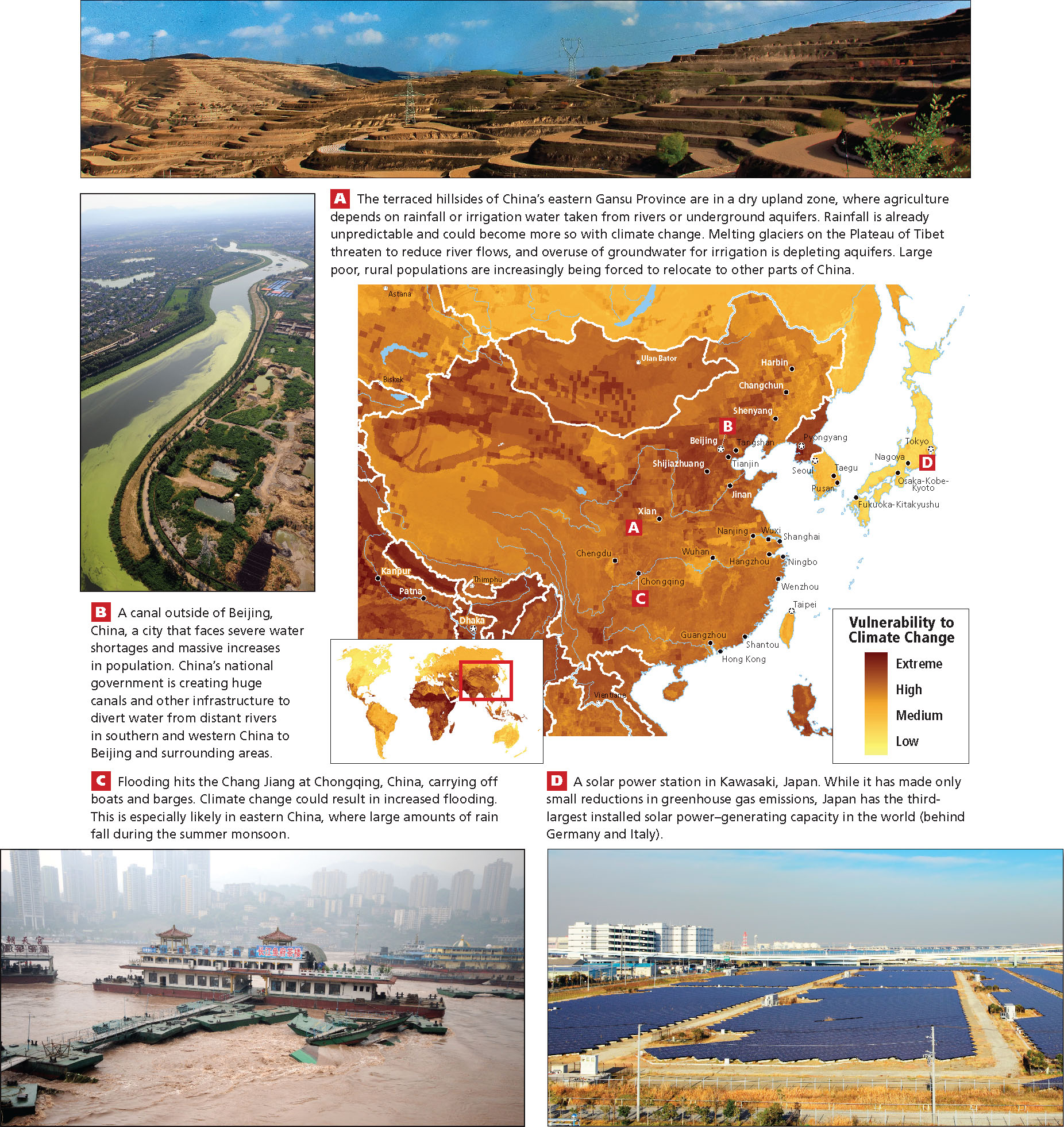
Thinking Geographically
After you have read about vulnerability to climate change in East Asia, you will be able to answer the following questions:
Question
 What are some of the vulnerabilities faced by people who live or farm in dry environments like the terraced slopes in eastern Gansu Province?
What are some of the vulnerabilities faced by people who live or farm in dry environments like the terraced slopes in eastern Gansu Province?
| A. |
| B. |
| C. |
| D. |
Question
 What is causing the water table to fall each year on the North China Plain?
What is causing the water table to fall each year on the North China Plain?
| A. |
| B. |
| C. |
| D. |
Question
 Flooding is especially likely in what part of China?
Flooding is especially likely in what part of China?
| A. |
| B. |
| C. |
| D. |
Climate Change: Emissions and Vulnerability in East Asia
Geographic Insight 1
Climate Change and Water: East Asia has long suffered from alternating droughts and devastating floods, and scientists fear that these hazards will only intensify with climate change. Meanwhile, the rivers of China, many of which originate in the Tibetan and neighboring plateaus, are dependent both on seasonal rainfall cycles and on glacial meltwater that are expected to diminish over the next few decades.
Climate change, especially global warming, is a growing concern in East Asia. China now leads the United States as the world’s largest overall producer of greenhouse gases (but still produces less than a third of U.S. emissions on a per capita basis; see Figure 1.23A); Japan is also a major emitter. China has recently been working on limiting its emissions, perhaps out of recognition of its responsibility as an increasingly influential global economic power. However, even with large gains in efficiency through the use of new technologies, China’s greenhouse gas emissions make up almost a quarter of the world’s total. They will possibly double by 2030 as its urban households use more cars, air conditioning, appliances, and computers.
China’s Vulnerability to Glacial Melting
Glaciers on the Plateau of Tibet capture monsoon moisture and store it as ice from which meltwater is then slowly released. Two of China’s largest rivers, the Huang He and the Chang Jiang, are partially fed by these glaciers, which are now melting so rapidly that scientists predict they will eventually disappear. One effect could be significantly lower flows in these two great rivers during the winter, when little rain falls. Both have already begun to run low during winter, and trade has been affected because riverboats and barges have become stranded on sandbars. Another effect could be a reduction in the amount of irrigation water available for dry-season farming.
Water Shortages
Nearly every year, abnormally low rainfall or abnormally high temperatures create a drought somewhere in China. These droughts often cause more suffering and damage than any other natural hazard.
Droughts can be worsened by human activity on a local or regional scale. When people begin to live or farm in dry environments, as many millions have done in China and Mongolia during the twentieth century, desertification (see Chapter 6) can result. People clear vegetation to grow crops, which require more water than the natural vegetation, so the crops must be irrigated with water pumped to the surface from underground aquifers (see Figure 9.5A). Many dry areas in China are subject to strong winds that can blow away topsoil once the vegetation is removed. Furthermore, irrigated crops are often less able than natural vegetation to hold the soil; this was, for example, part of what helped create the 1930s Dust Bowl in the central United States (see Chapter 2). Huge dust storms have plagued China in recent years. High dunes of dirt and sand have appeared almost overnight in some areas that border the desert, threatening crops, roads, and homes. Dust storms can also move over long distances from western China and affect large cities, such as Beijing, near the coast. Particulate matter from these dust storms even circles the entire globe in the upper atmosphere.
VIGNETTE
In the Ningxia Huizu Autonomous Region on the Loess Plateau in northwest China, Wang Youde squints out at what are now sand-colored low hills barren of vegetation. He explains how these vast tracts of former farmland have been transformed into deserts by a combination of human error and climate change.
The area was already prone to drought and wind (loess means “wind-deposited soil”), and then agricultural expansion into areas that have this fragile, wind-deposited soil led to the removal of thick, natural, deep-rooted grasses. One can still see the agricultural terraces on the arid slopes where now not even grass grows. Wang Youde’s family and 30,000 others fled the area when Youde was 10 years old because one day a sand dune covered their village. From his early childhood, he remembers flowers, bird song, and occasional snowfalls; all have vanished. Now Youde is back, heading up a project to revegetate thousands of hectares with drought-resistant plants that will hold the soil. By hand, squares of braided straw or stones are laid down to keep water from running off the land and to protect planted seedlings. The seedling survival rate is only 20 to 30 percent. Yet, Youde says, “Every time we see an oasis that we have created we are very satisfied…[b]ecause we have poured sweat and blood into our work.” His adult children are helping him, hoping to remain with the family and escape the hardships of migrating to find urban factory work. [Source: Asia Pacific News. For detailed source information, see Text Credit pages.] 
Water shortages are particularly intense in the North China Plain, which produces half of China’s wheat and a third of its corn. Here the water table is falling more than 10 feet per year because of the increased use of groundwater for irrigation and urban needs. Meanwhile, withdrawals of water from the Huang He often make the river’s lower sections run completely dry during the winter and spring. A gigantic development called the South–North Water Transfer Project is underway to rectify the problem (see Figure 9.5B). The goal is to divert water from the Chang Jiang basin in central China to the Huang He basin in the north. To address the unbalanced regional access to water, diversion canals are being constructed at multiple locations, from the Plateau of Tibet in the west to the coastal provinces in the east. The project is not expected to be completed until 2050.
With regard to its water-related vulnerabilities, China is focusing on water conservation to stretch existing supplies. Already, 30 percent of China’s urban water is recycled, and many cities are trying to raise this percentage. A major new national effort to remove pollutants from wastewater discharged by industry and farming is indicative of official support for these conservationist policies. Japan, the Koreas, and Taiwan have monsoon rainfall patterns, which give them a generally wetter climate and make them less vulnerable to drought than China and Mongolia.
Flooding in Central China
The same shifting patterns of rainfall that may worsen droughts can also worsen flooding. Under usual conditions, the huge amounts of rain deposited on eastern China during the summer monsoon periodically can cause catastrophic floods along the major rivers. If global warming leads to even slight changes in rainfall patterns, flooding could be much more severe (see Figure 9.5C). Engineers have constructed elaborate systems of dikes, dams, reservoirs, and artificial lakes to help control flooding. However, these systems failed in 1998, when heavy rains in the Chang Jiang basin caused some of the worst flooding in decades, resulting in the death of approximately 4000 people. The pattern is now repeating frequently on the Chiang Jiang and other rivers in central and southern China (significant floods happened in 2010, 2011, and 2012). Every year there are large numbers of casualties from drowning and mudslides.
Natural Hazards and Energy Vulnerability
Until the Sendai earthquake and tsunami of 2011, Japan, along with many other countries, planned to increase the use of nuclear power as a way to reduce greenhouse gas emissions. However, the tsunami washed over the Fukushima nuclear plant and destroyed its cooling systems, which caused a meltdown of several of the plant’s nuclear reactors. The severity of the nuclear disaster that followed in the wake of the tsunami halted or curtailed many plans for expanding nuclear power in Japan and across the globe. The accident forced the evacuation of over 200,000 people; temporarily contaminated the water supply of Tokyo; contaminated the ground, food, and livestock for miles around the reactor; released thousands of gallons of water containing 10,000 times the normal level of iodine-131 (a radioactive substance) into the Pacific Ocean; and sent enough radiation into the atmosphere that scientists detected measurable radiation increases in the United States and Europe. The accident is expected to boost reliance both on renewable resources and on fossil fuel in the near future.
ON THE BRIGHT SIDE
Responses to the Climate Crisis
East Asia is increasingly responding to the warming aspect of global climate change. Japan has led such efforts for decades. In 1997, the Japanese city of Kyoto hosted the meeting in which countries first committed to reduce their greenhouse gas emissions. Japanese automakers such as Toyota were among the first to develop and sell hybrid gas-electric vehicles, and Japan is now third only to Germany and Italy in its installed solar power–generating capacity (see Figure 9.5D). However, Japan has made only small actual reductions in its greenhouse gas emissions.
Food Security and Sustainability in East Asia
Geographic Insight 2
Food and Globalization: East Asian countries have enough economic development to be able to buy food on the global market, but they are less able to produce sufficient food domestically. Much agricultural land has been lost to urban and industrial expansion and to mismanagement, but the increase in the region’s affluence has led to a demand for more imported food.
food security when people consistently have access to sufficient amounts of food to maintain a healthy life
From one perspective, high levels of imported food are a sign of increasing food security in East Asia, because countries with competitive globalized economies can afford to bring in food from elsewhere. However, recent dramatic increases in global food prices illustrate the perils of dependence on food imports, especially for the poor. In 2007–2008, the world market price for grain and other basic food commodities shot up, and it did so again in 2010–2011. The reasons for the increases in food prices are multifold, and include high oil prices (because producing food is often energy intensive), the use of corn to produce ethanol fuel (ethanol is used as a replacement for gasoline in the Americas and elsewhere) rather than as a food source, and the growing demand for agricultural commodities in China and other developing economies.  217. FOOD PRICES SKYROCKETING IN CHINA
217. FOOD PRICES SKYROCKETING IN CHINA
Food Production
Just over half of East Asia’s vast territory can support agriculture (Figure 9.6). In much of this area, food production has been pushed well beyond what can be sustained over the long term. As a result, East Asia’s fertile zones are shrinking. In China, roughly one-fifth of the agricultural land has been lost since the Communist Revolution of 1949, largely because of urban and industrial expansion and agricultural mismanagement that created soil erosion and desertification (see the vignette).
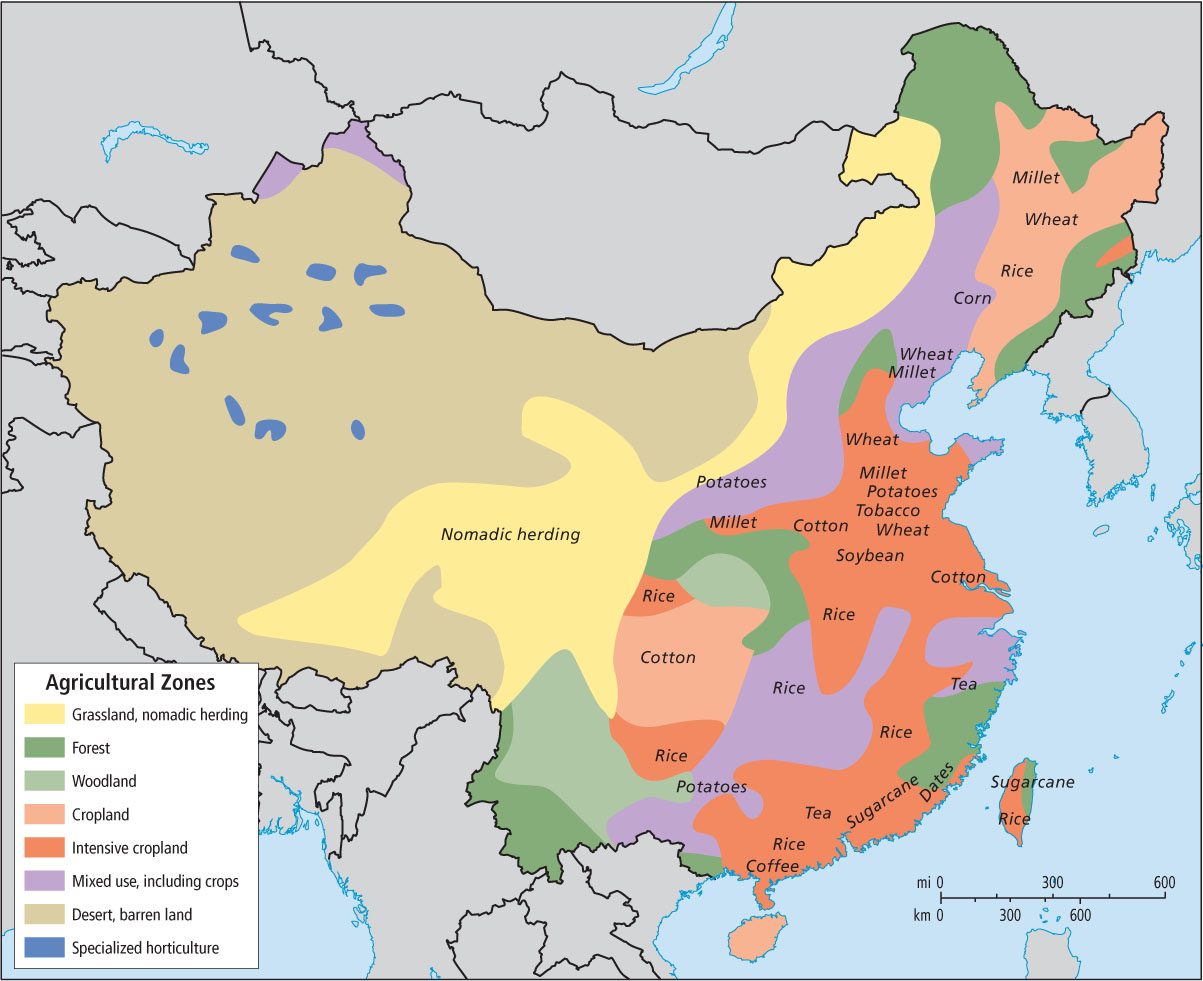
As urban populations grow more affluent, they consume more meat and other animal products that require more land and resources than did the plant-based national diet of the past. Soybeans, which used to be important as an export for China, are one example of this change in diet. More than 70 percent of the soybeans used in China are now imported, primarily from the United States, Brazil, and Argentina. Soybeans are no longer used mainly for human food but for animal feed, for farmed fish food, and especially for high-grade cooking oil. Figure 9.7 shows, however, that vegetable dishes with an ancient history do remain popular in many parts of East Asia (see Figure 9.7A), and that meat and dairy dishes are still prepared in traditional ways in places where raising farm animals has been the norm (see Figure 9.7C).
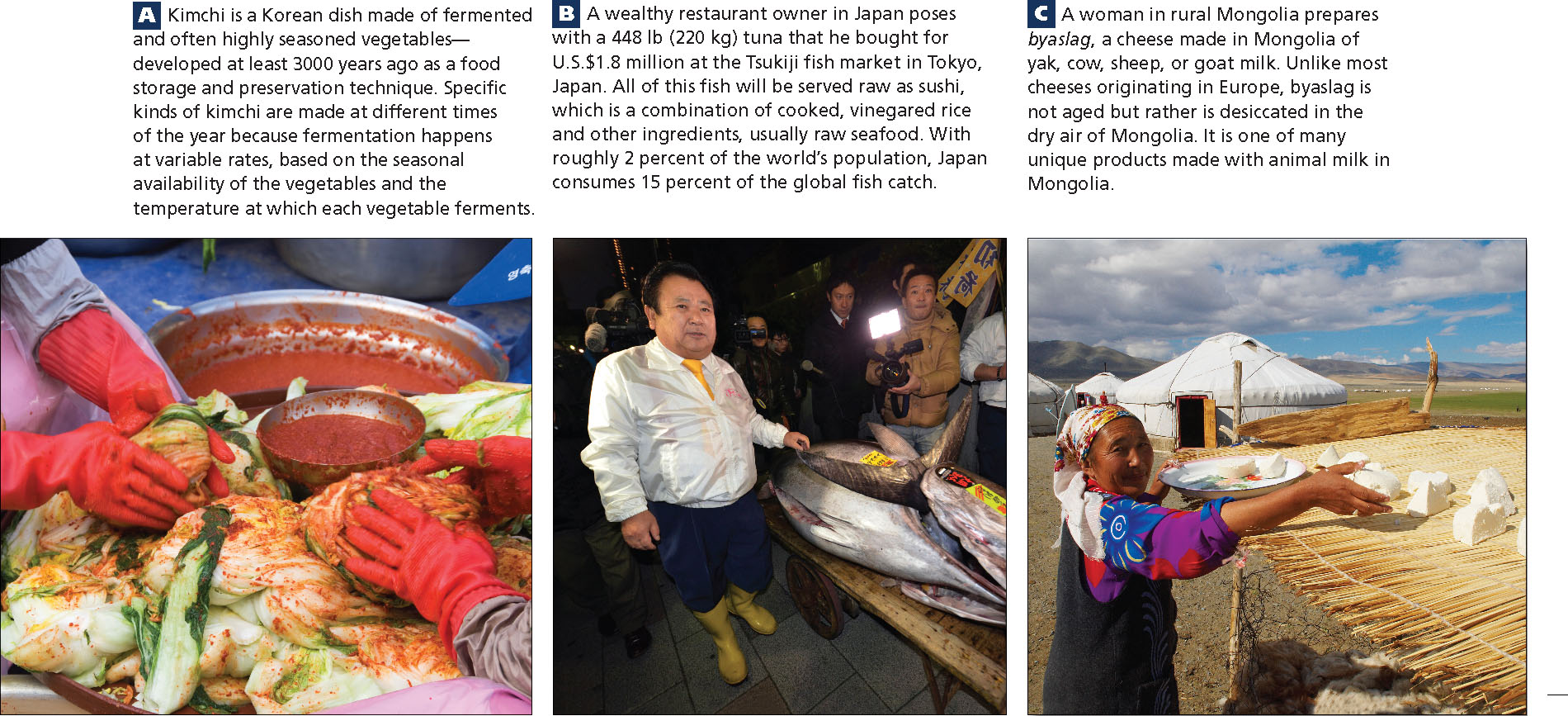
Rice Cultivation
wet rice cultivation a prolific type of rice production that requires the plant roots to be submerged in water for part of the growing season
Wet rice cultivation requires elaborate systems of water management, as the roots of the plants must be submerged in water early in the growing season. Centuries of painstaking human effort have channeled rivers into intricate irrigation systems, and whole mountainsides have been transformed into descending terraces that evenly distribute the water. Writing about wet rice cultivation in Sichuan Province, geographer Chiao-Min Hsieh describes how “[e]verywhere one can hear water gurgling like music as it brings life and growth to the farms.” However, these same cultivation techniques, combined with extensive forestry and mining, have led to the loss of most natural habitats in all but the most mountainous, dry, or remote areas. With so little suitable agricultural land left, further expansion of the area under wet rice cultivation is unlikely.
Fisheries and Globalization
Many East Asians depend heavily on ocean-caught fish for protein (see Figure 9.7B). People in Japan, South Korea, and Hong Kong eat more than twice as much fish and shellfish as do Americans. The Japanese, in particular, have had a huge impact on the seas of not only this region, but also of the entire world. With less than 2 percent of the world’s population, Japan consumes 15 percent of the global wild fish catch. There are some 4000 coastal fishing villages in Japan, sending out tens of thousands of small crafts to work nearby waters each day. Large Japanese fishing vessels, complete with onboard canneries and freezers, harvest oceans around the world. They can do so because waters at a certain distance away from land, typically 200 nautical miles (230 miles or 370 kilometers) are considered international waters and outside the jurisdiction of any individual country. In part because of Japan’s global fishing practices, environmentalists have criticized the country for overfishing. For example, Japanese fishing off western Africa has reduced the catches of local fishers so much that many have been forced to migrate to Europe for work. However, there is little room for Japan to expand its fish imports. The global fish catch has been static since 1990 because much of the world’s fishing grounds are either fully exploited or in decline.
People in China are also dependent on fish protein in their diets. China is, in fact, the world’s largest fish producer, and much of the output is consumed domestically. However, most of China’s fishing industry is based on aquaculture rather than on wild-caught fish.
People and Animals
The use of animals in East Asia is not solely for the purpose of food production. For example, the role of East Asia’s aquaculture is also to contribute to the aesthetic beauty of carefully manicured landscapes. Specifically, carp have been domesticated and bred in Japan to have a variety of colors and patterns (Figure 9.8C). These carp are commonly found in the ponds of Japanese gardens. As an adaptive species that does well under a wide variety of aquatic conditions, ornamental carp are now found around the world.

A practice that is less geographically widespread is traditional Chinese medicine, which, in part, involves the capturing of wild animals. Such animals are found in markets around China because they are believed to have healing properties (see Figure 9.8A). Unfortunately, some species are endangered due to this practice.
In Mongolia, many species of animals are fundamental to nomadic husbandry, a way of life that is common in areas of dry grasslands around the world (see Figure 9.8B). As Mongolia modernizes, such nomadic lives, there and elsewhere in East Asia, are becoming less common than they were in the past (Figure 9.40).
THINGS TO REMEMBER
 Geographic Insight 1Climate Change and Water East Asia has long suffered from lengthy searing droughts and devastating floods. These disruptions are likely to increase with global climate change.
Geographic Insight 1Climate Change and Water East Asia has long suffered from lengthy searing droughts and devastating floods. These disruptions are likely to increase with global climate change. China’s main river systems are being affected by the melting of its glaciers, which ultimately leads to water shortages.
China’s main river systems are being affected by the melting of its glaciers, which ultimately leads to water shortages. The region’s most important grain is rice, and over the millennia, rice cultivation has transformed landscapes throughout central and southern China, and Japan, the Koreas, and Taiwan.
The region’s most important grain is rice, and over the millennia, rice cultivation has transformed landscapes throughout central and southern China, and Japan, the Koreas, and Taiwan. Geographic Insight 2Food and Globalization About three-quarters of the food consumed in Japan, South Korea, and Taiwan is imported. So far, China is self-sufficient with regard to basic necessities such as rice, but it is highly dependent on imports for other foods.
Geographic Insight 2Food and Globalization About three-quarters of the food consumed in Japan, South Korea, and Taiwan is imported. So far, China is self-sufficient with regard to basic necessities such as rice, but it is highly dependent on imports for other foods. People in East Asia consume much fish and other seafood. Some of this food is harvested in waters far away from East Asia.
People in East Asia consume much fish and other seafood. Some of this food is harvested in waters far away from East Asia.
Three Gorges Dam: The Power of Water
The Three Gorges Dam (see Figure 9.9A) is at this time the largest dam in the world at 600 feet (183 meters) high and 1.4 miles (2.3 kilometers) wide. It was designed to improve navigation on the Chang Jiang and control flooding, but it is most lauded for its role in generating hydroelectricity for this energy-hungry country that is working to reduce its greenhouse gas emissions. But the dam also comes with a social cost. The Chinese environmental activist Dai Qing notes that China has 22,000 large dams, all of which have displaced people—perhaps as many as 60 million—without any attention to their rights as stakeholders in the projects.
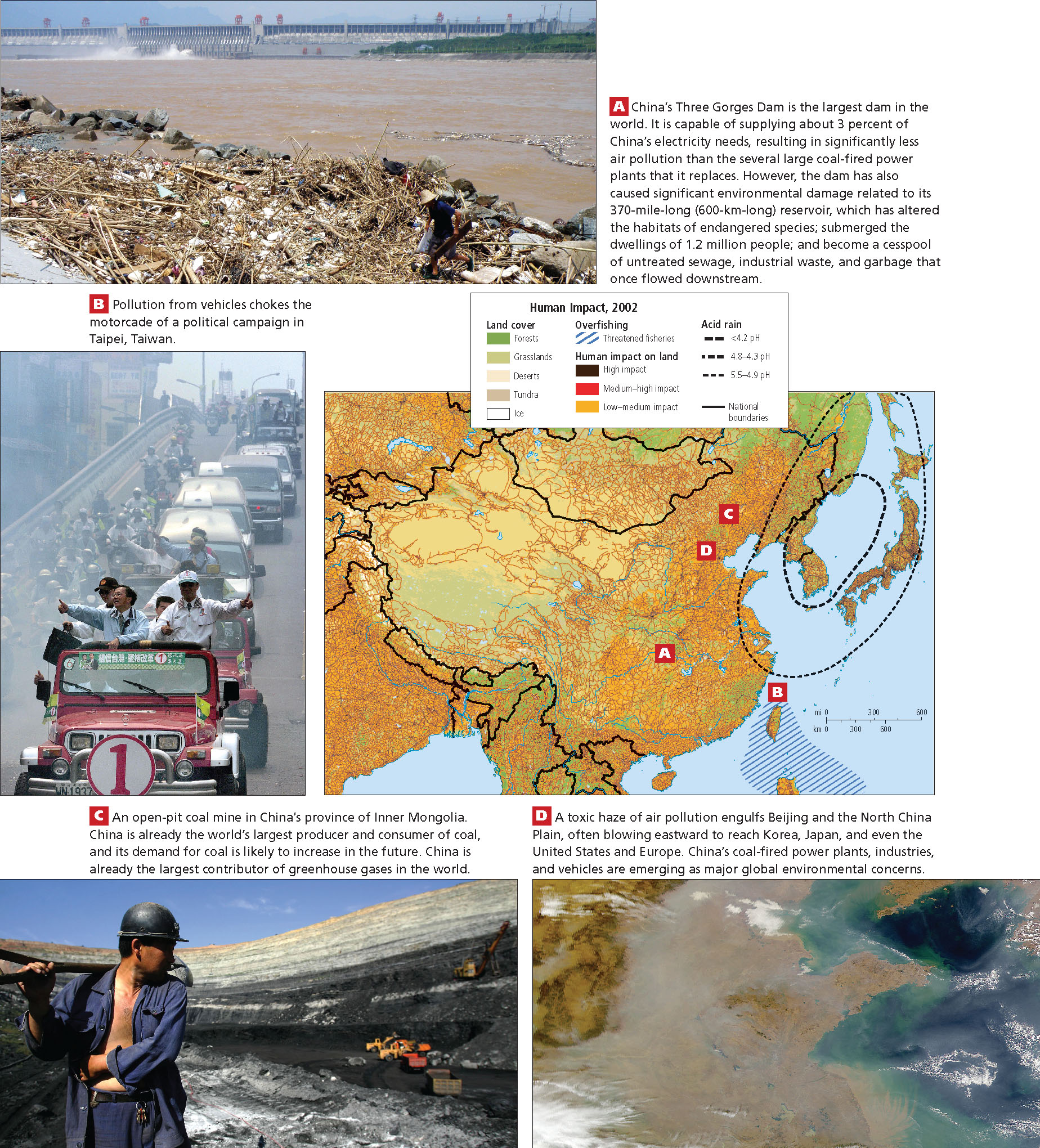
Thinking Geographically
After you have read about human impacts on the biosphere in East Asia, you will be able to answer the following questions:
Question
 Which design flaw is of greatest concern to experts involved with the Three Gorges Dam project?
Which design flaw is of greatest concern to experts involved with the Three Gorges Dam project?
| A. |
| B. |
| C. |
| D. |
Question
 Why is air pollution so serious in Taiwan?
Why is air pollution so serious in Taiwan?
| A. |
| B. |
| C. |
| D. |
Question
 What percentage of the world's total of coal is burned annually in China?
What percentage of the world's total of coal is burned annually in China?
| A. |
| B. |
| C. |
| D. |
Question
 What allows particulates from China's coal burning to be transported globally?
What allows particulates from China's coal burning to be transported globally?
| A. |
| B. |
| C. |
| D. |
Many experts involved with the Three Gorges project see serious design flaws. Of greatest concern is the dam’s position above a seismic fault. The dam was built at the east end of the Three Gorges because the deep canyons provided a prodigious reservoir for water to power turbines, providing electricity for all of central China, from the sea to the Plateau of Tibet. Unfortunately, the enormous weight of the water and its percolation through geological fissures in the 370-mile-long (600-kilometer-long) reservoir behind the dam could trigger earthquakes. Already at issue are huge landslides along the gorges, lubricated by the rising reservoir water. Meanwhile, cracks in the dam raise doubts about its structural integrity. Similar defects led to the failure of China’s much smaller Banqiao Dam during a 1975 typhoon, which was responsible for about 150,000 deaths from the flooding and an ensuing famine. Even if the dam holds, its potential to generate power will probably be reduced by the buildup of eroded silt behind the dam.
Any failure of the dam would be a financial as well as human disaster. Official construction costs are $25 billion, but the real costs may end up being three times this figure, due in part to unforeseen negative environmental and social impacts and to theft from the project by corrupt officials.
Also of concern are the incalculable costs associated with relocating the 1.2 million people who once lived where the dam now forms a reservoir. Thirteen major cities have been submerged, along with 140 large towns, hundreds of small villages, 1600 factories, and 62,000 acres (25,000 hectares) of farmland. In some cases, communities were rebuilt immediately uphill from the submerged location and people only had to relocate a short distance; others had to migrate to distant parts of the country. The reservoir has also destroyed important archaeological sites, as well as some of China’s most spectacular natural scenery. There are significant environmental costs as well. The giant sturgeon, for example, a fish that can weigh as much as three-quarters of a ton and is as rare as China’s giant panda, may become extinct. Sturgeon used to swim more than 1000 miles (1600 kilometers) up the Chang Jiang past the location of the dam to spawn. Now the sturgeon’s reproductive process has been irretrievably interrupted.  209. THREE GORGES DAM LEAVES SOME CHINESE SWAMPED
209. THREE GORGES DAM LEAVES SOME CHINESE SWAMPED
The plan to build the Three Gorges Dam came just as UN development specialists were deciding that the benefits dams could bring do not sufficiently outweigh the many problems they cause. Decades ago, international funding sources such as the World Bank withdrew their support for the Three Gorges Dam because of concerns over the social and environmental costs and other shortcomings of the project. However, Chinese industrialists who need the energy, construction companies that have prospered from building the dam and its many ancillary projects, and government officials eager to impress the world and leave their mark on China continue not only to support the Da Ba (the Big Dam), but also to look for other locations around the world where China can gain influence and profit by building dams.
Air Pollution: Choking on Success
Air pollution is often severe throughout East Asia, but the air quality in China’s cities is particularly poor. After South Asia, the pollution in these cities ranks among the worst in the world. As China’s economy and population grow—especially in urban areas—demands for energy for households, industry, and transportation also go up. Coal burning is the primary source of pollution. China is the world’s largest consumer and producer of coal, accounting for 46 percent of all the coal burned on the planet each year (Figure 9.9C, D). Between 1980 and 2011, China’s coal consumption grew sixfold. By 2006, China was bringing a new coal-fired power plant online every week. The pace of expansion has slowed somewhat since then in favor of other energy sources. Nevertheless, at any given point in time, there are still hundreds of new coal-fired plants in the planning stages in China.
Air Pollution in China
The combustion of coal releases high levels of pollutants—suspended particulates, smog-causing ozone, and sulfur dioxide—all of which can cause respiratory ailments. In Chinese cities, these emissions can be many times higher than what the World Health Organization (WHO) defines as safe. Figure 9.10 shows that almost no Chinese cities have air quality that is classified as “good” with regard to one type of pollutant—particulates. The worst pollution is often in cities, where homes are in close proximity to industries that depend heavily on coal for fuel. The use of coal to heat homes can also be detrimental, as the following vignette shows.
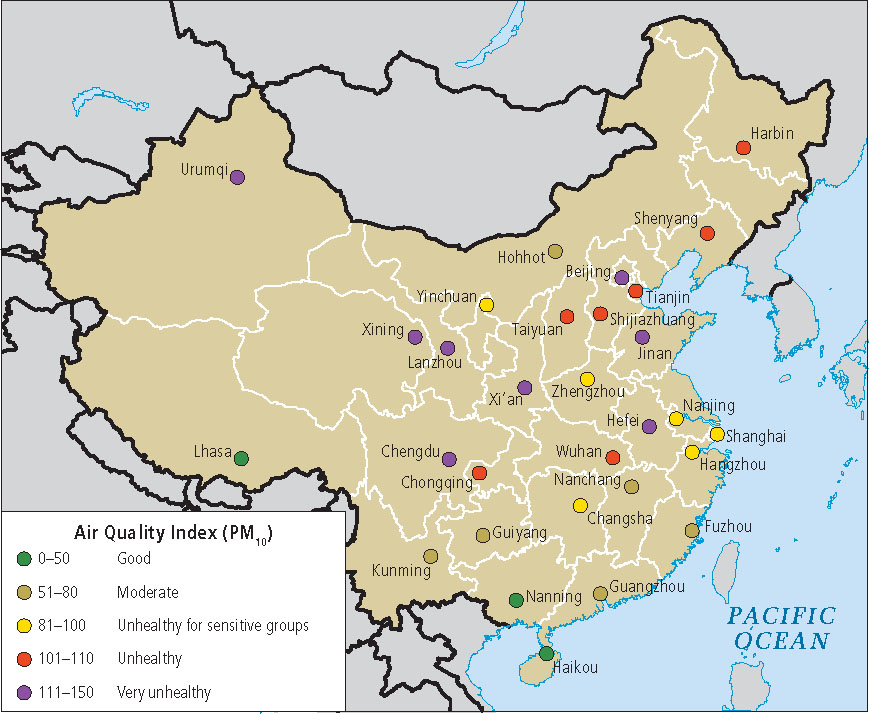
VIGNETTE
Every winter, the elderly couple got through the biting Beijing winters by feeding 1200 one-kilogram coal bricks into a small iron stove. The ashes and coal dust blackened their belongings, and they worried about carbon monoxide poisoning. Then, in 2009 they were given a new electric space heater by the city government. In a move to clean up Beijing’s air and reduce the city’s contribution to China’s greenhouse gas emissions, the city replaced nearly 100,000 old coal stoves with electric heaters and cut electric nighttime rates to just 3 cents per kilowatt-hour. The couple was astonished with the change the new cheap heater made in their lives. But of course, 100,000 more homes were now dependent on electrical power, most of it generated by coal-fired power plants. [Source: New York Times/International Herald Tribune Global Edition. For detailed source information, see Text Credit pages.] 
Sulfur dioxide from coal burning also contributes to acid rain, which is displaced to the northeast by prevailing winds, reaching the Koreas, Japan, Taiwan, and beyond. Japan and Taiwan are particularly afflicted (see Figure 9.9B, D, and map). Particulates from China’s coal burning are transported globally by high-altitude, west-to-east flowing jet streams, thus affecting air quality in North America and Europe. Locally, toxic mercury from coal plants accumulates in aquatic life and, ultimately, in humans.
Air pollution from vehicles is also severe, even though the use of cars for personal transportation in China is just beginning. For years, China’s vehicles have had very high rates of lead and carbon dioxide emissions. Quite recently, the government has begun to work on the problem. As of 2008, new Chinese cars had to meet EU standards for mileage and emissions—which are much stricter than those for U.S. cars. Even so, to provide decent air quality during the 2008 Summer Olympics, China removed half of Beijing’s cars from the road. A number of polluting industries were temporarily shut down as well. The actions had the intended effect: Beijing’s air was noticeably better during the Olympic summer.  203. WORLDWATCH INSTITUTE: 16 OF 20 OF WORLD’S MOST POLLUTED CITIES IN CHINA
203. WORLDWATCH INSTITUTE: 16 OF 20 OF WORLD’S MOST POLLUTED CITIES IN CHINA
Air Pollution Elsewhere in East Asia
Public health risks related to air pollution are also serious in the largest cities of Japan (Tokyo and Osaka), Taiwan (Taipei), Mongolia (Ulan Bator), and South Korea (Seoul), and in adjacent industrial zones. Even with antipollution legislation and increased enforcement, high population densities and rising expectations for better living standards make it difficult to improve environmental quality. Taiwan is a case in point.
Taiwan has some of the dirtiest air in the world. Some of the main causes are the island’s extreme population density of 250 people per square mile (646 per square kilometer), its high rate of industrialization, and its close proximity to industrialized south China. There are now 4 motor vehicles (cars or motorcycles) in Taiwan for every 5 residents—more than 18.5 million exhaust-producing vehicles on this small island. In addition, there are nearly eight registered factories for every square mile (three per square kilometer), all emitting waste gases. The government of Taiwan acknowledges that the air is six times dirtier than that of the United States or Europe.
Both North and South Korea depend on hydro- or nuclear-generated electricity to run factories and heat buildings, unlike elsewhere in East Asia. North Korea has relatively few industries and uses very few cars, so, although reliable data are not available for North Korea, its air pollution levels are thought to be low for the region. South Korea uses fossil fuels in its numerous industries and has many gasoline-powered cars. These are the sources of most of its internally generated air pollution. Mongolia generally has the region’s cleanest air; but in Ulan Bator, pollution from coal heaters has inspired some imaginative projects. For example, whole sections of Ulan Bator are now heated by centrally located boilers, which supply hot water to apartment buildings and individual dwellings.
THINGS TO REMEMBER
 In an effort to address droughts, floods, and the burgeoning need for electricity, China has built many dams, the largest of which is the Three Gorges Dam, which itself now poses many potential problems.
In an effort to address droughts, floods, and the burgeoning need for electricity, China has built many dams, the largest of which is the Three Gorges Dam, which itself now poses many potential problems. Rapid urban economic development in East Asia, combined with weak environmental protection, has resulted in some of the most polluted cities on the planet.
Rapid urban economic development in East Asia, combined with weak environmental protection, has resulted in some of the most polluted cities on the planet.